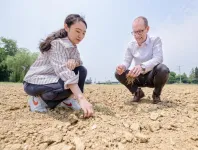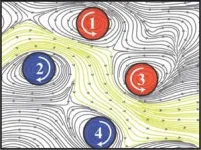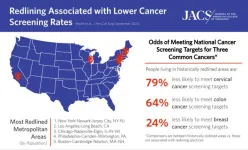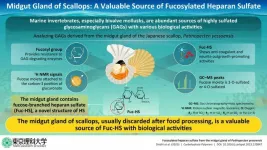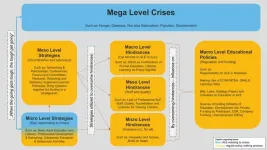(Press-News.org) As the world faces more climate variability and extremes in the face of global warming, sudden environmental changes add an extra layer of stress to food production in the United States and around the world. It is critical, then, to figure out how the areas in which crops are planted and harvested respond to these stressors, which can bring on ‘shocks’ in production – or, put differently, sudden and statistically significant crop declines.
These production shocks are a big concern in terms of food stability and many crops in the United States—such as corn, cotton, soybeans, and wheat — are all experiencing more frequent production reductions as a result of these shocks.
A new study published in the Nature Sustainability scientific journal and led by the University of Delaware’s Dongyang Wei looked at these production shocks and, specifically, how they are affected by variations in planted and harvested areas.
Kyle Davis, assistant professor in the Department of Geography and Spatial Sciences and the Department of Plant and Soil Sciences, as well as a resident faculty member with UD’s Data Science Institute, is coordinating author on the paper.
Wei, a doctoral candidate in the Department of Geography and Spatial Sciences, said prior studies have focused on crop yield and how the yield variability affects production but very few studies have looked at the role of planted and harvested areas. Because production is the combined result of how much area a farmer plants (the planted area), how much of that area they can harvest (the harvested area) and the yield of the crop in that area, it is important to evaluate all three of these factors when assessing production stability.
“What we did was to focus on the U.S., the world’s largest producer and exporter of cereal grains, to see how these three components—crop yield, planted area, and harvested area—affected food production stability and to what degree they are related to climate extremes,” said Wei.
For the study, the researchers looked at county-level data on seven crops: barley, corn, cotton, sorghum, soybeans, spring wheat, and winter wheat.
These are the main crops that are grown in the United States, accounting for about 70 percent of the country’s total cropland. In addition to being widely produced, they have a lot of readily available data that covers a long time period. As a result, the researchers were able to look at data sets from 1978-2020.
“Agriculture is one of the sectors most directly exposed to the effects of climate change,” said Davis. “Understanding how the stability of crop production is influenced by variations in yield, planted area, and harvested area – and how these influences may differ between crops – is critical to more effectively adapting agriculture in the face of rising climate change and extreme climate events. Dongyang’s research is an important contribution to our understanding on this topic.”
Using time-series data and statistical methods to detect how frequently shocks occur, they found that shocks in planted and harvested areas co-occur with more than half of the production shocks for the study crops.
They then looked at the extent to which each of the three components contribute to the size of a production shock and found that while yield fluctuations contribute more than the other two components for corn, cotton, soybean and winter wheat, changes in planted and harvested areas play a more important role in the magnitude of production shocks for barley, sorghum and winter wheat.
Wei said this is important because it shows that researchers should focus on all three variables instead of simply focusing on the yield and ignoring the planted and harvested areas.
“We want to raise the importance of considering all three of the components when we are facing rising climate variability and climate disruptions on the food systems,” said Wei. “Yield is important, but an exclusive focus on yield stability severely constrains the solution space. If we want to have greater flexibility in adapting agriculture to climate change, we should focus on ways to stabilize planted and harvested areas too. The producers’ decisions on cropping patterns can play a crucial role in stabilizing food production.”
END
Shock to the crop system
New study evaluates how climate shocks impact the planted and harvested areas for crops
2023-06-15
ELSE PRESS RELEASES FROM THIS DATE:
Researchers demystify the unusual origin of the Geminids meteor shower
2023-06-15
The Geminids meteoroids light up the sky as they race past Earth each winter, producing one of the most intense meteor showers in our night sky.
Mysteries surrounding the origin of this meteoroid stream have long fascinated scientists because, while most meteor showers are created when a comet emits a tail of ice and dust, the Geminids stem from an asteroid — a chunk of rock that normally does not produce a tail. Until recently, the Geminids had only been studied from Earth.
Now, Princeton researchers used observations from NASA’s Parker Solar Probe mission to deduce that it was likely a violent, ...
Historic redlining practices cast a long shadow on cancer screening rates
2023-06-15
Key Takeaways
Banned since 1968, the legacy of redlining persists: There continue to be instances of discrimination affecting people in these historically redlined areas.
Redlining was associated with lower odds of hitting screening targets for all three types of cancer: 24% lower odds in breast cancer, 64% lower odds in colorectal, and 79% lower odds in cervical cancer, compared with non-redlined areas.
Actionable initiatives to improve cancer screening rates: Questionnaires to determine barriers to cancer screening, mobile cancer screening ...
Midgut gland of scallops: a valuable source of fucosylated heparan sulfate
2023-06-15
Glycosaminoglycans (GAGs), including chondroitin sulfate (CS), heparan sulfate (HS), heparin, and hyaluronan are linear and acidic polysaccharides found in the extracellular matrix of all animal tissues. GAGs are widely used as functional ingredients in health products, pharmaceuticals, and cosmetics, and are prepared from biological samples such as shark cartilage and porcine intestinal mucosa. Consequently, the demand for new sources of GAGs is ever-present. For example, the supply source of the anticoagulant heparin—generally prepared from porcine intestinal mucosa in China—was threatened by African swine fever in 2018.
GAGs derived from marine invertebrates—animals ...
University of Cincinnati research finds potential therapy for rare but devastating lung disease
2023-06-15
A treatment for a rare cancer-like lung disease found in women of childbearing age may have been discovered by University of Cincinnati researchers.
The rare lung disease is called lymphangioleiomyomatosis or LAM, and the cause of it is unknown with no cure established. New UC research, funded by the National Heart, Lung, and Blood Institute, discovered that two existing drugs show signs of being effective in treating LAM and could lead to the development of a cure.
The study was published in Science Advances,
“The exact number of women with LAM is unknown but it is estimated that for every 1 million women in the world, three to seven ...
Insilico Medicine’s transformer-based aging clock provides insights into aging, disease, and new therapeutic targets
2023-06-15
Clinical stage generative artificial intelligence (AI)-driven drug discovery company Insilico Medicine (“Insilico”) has announced a new multimodal transformer-based aging clock that is capable of processing diverse data sets and providing insights into biomarkers for aging, mapping them to genes relevant to both aging and disease, and discovering new therapeutic targets designed to slow or reverse both aging and aging-related diseases. The company calls the aging clock Precious1GPT, in a nod to the powerful “One Ring” in Lord of the Rings. The findings were published in the June 13 issue of the journal Aging.
Insilico has been ...
Hip fracture burden to nearly double worldwide by 2050
2023-06-15
An international group of researchers led by the Department of Pharmacology and Pharmacy, LKS Faculty of Medicine, the University of Hong Kong (HKUMed), and including Douglas P Kiel, MD, MPH, Director Musculoskeletal Research Center, Marcus Institute for Aging Research, Hebrew SeniorLife, and Professor of Medicine, Harvard Medical School, evaluated the secular trends in hip fracture incidence, treatment patterns following a hip fracture, and all-cause mortality in 19 countries and regions from 2005 to 2018. While the age- and sex-standardised hip fracture incidence rates decreased ...
Research findings „Study on Adult Learning and Education“
2023-06-15
From August 2022 until October 2022, interviews with 25 experts from the selected countries were conducted and then analyzed trough a Ground Theory approach. From this, a model emerged, showing how factors and actors at different societal levels - mega, macro, meso and micro - interact to shape adult learning and education in different contexts.
Mega level comparisons show that overarching issues such as war and conflict, historical and systemic discrimination, disease and extreme poverty as well as political authoritarianism act both as an impetus and as barriers to ALE activities.
Comparative analysis shows that at the macro level, with ...
New tool uncovers COVID-19 susceptibility mechanism
2023-06-15
Researchers have discovered a mechanism for COVID-19 susceptibility using a newly created tool. The tool, GASPACHO, captures dynamic changes in gene expression along the innate immune response, allowing researchers to identify genes and molecular pathways associated with disease risk that have previously been too complex to detect or interpret.
Using GASPACHO (GAuSsian Processes for Association mapping leveraging Cell HeterOgeneity), researchers at the Wellcome Sanger Institute, the National Center for Child Health and Development in Japan, Tel Aviv University and their collaborators have identified a gene variant that affects COVID-19 susceptibility. ...
Jefferson Lab oversight roles filled by DOE
2023-06-15
NEWPORT NEWS, VA – The U.S. Department of Energy has selected Craig Ferguson to lead the Thomas Jefferson Site Office (TJSO) at the Thomas Jefferson National Accelerator Facility in Newport News, Va. As TJSO manager, Ferguson will lead in the oversight and contract management of Jefferson Lab. Additionally, Donté Davis has been confirmed as TJSO deputy manager, a role he first stepped into earlier this year.
Ferguson is familiar with Jefferson Lab and its mission, having already served in a leadership role at the lab. In 2005-2008, he was the lab’s associate director for environment, safety, health & quality.
“I am excited to return ...
High-quality child care contributes to later success in science, math
2023-06-15
Children who receive high-quality child care as babies, toddlers and preschoolers do better in science, technology, engineering and math through high school, and that link is stronger among children from low-income backgrounds, according to research published by the American Psychological Association.
“Our results suggest that caregiving quality in early childhood can build a strong foundation for a trajectory of STEM success,” said study author Andres S. Bustamante, PhD, of the University of California Irvine. “Investing in quality child care and early childhood education could help ...
LAST 30 PRESS RELEASES:
Strategic river sensors could have forewarned of Texas Camp flood disaster
Drone sampling of whale breath reveals first evidence of potentially deadly virus in Arctic
Roman soldiers defending Hadrian’s Wall infected by parasites, study finds
Pinochet’s prisoners were tormented with music but still found solace in it, a new book reveals
Fertility remains high in rural Tanzania despite access to family planning
AI-assisted device can improve autism care access
Kinetic careers
Uncovering how parasitic plants avoid attacking themselves to improve crop resistance
Nanoparticle vaccine strategy could protect against Ebola and other deadly filoviruses
Study finds brain care score can predict risk of stroke across racial groups
Key lung immune cells can intensify allergic reactions
Do hormones explain why women experience more gut pain?
New materials conduct ions in solids as easily as in liquids
Breakthrough of the Year: Renewable energy begins to eclipse fossil fuel-based sources
LLM use is reshaping scientific enterprise by increasing output, reducing quality and more
Introducing LightGen, a chip for ultra-fast, ultra-efficient generative AI
Astronomers see fireworks from violent collisions around nearby star
ACC/AHA issue new guideline on managing congenital heart disease in adults
Cosmic crash caught on camera
Is talented youth nurtured the wrong way? New study shows: top performers develop differently than assumed
Ants: An untapped resource in the development of antibiotics?
Archaeologists use AI to create prehistoric video game
Mitochondria migrate toward the cell membrane in response to high glucose levels
Tiny viral switch offers hope against drug-resistant bacteria
Most parents aware of early peanut introduction guidelines, but confused about details
HPV vaccine can protect against severe lesions of the vulva and vagina
Virtual care provision and emergency department use among children and youth
Quadrivalent HPV vaccine and high-grade vulvovaginal lesions
Insights into dry eyes gained from stem cell-derived tear glands
Researchers identify 166 human pluripotent stem cell lines available for use in clinical applications
[Press-News.org] Shock to the crop systemNew study evaluates how climate shocks impact the planted and harvested areas for crops
